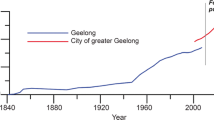Abstract
Oxygen isotopic data were used to assess how far waters from the Savannah River, a major river in the Southeastern United States, backed up and inundated the wetlands along a small Coastal Plain tributary during a flood. This approach worked because the water of this tributary, Unper Three Runs, had an oxygen isotopic composition (δ18O = −4.9 ‰) distinct from Savannah River water (δ18O = −3.2 ‰).
Two sample surveys were taken from the mouth of Upper Three Runs to 2 km upstream. Waters were isotopically uniform along the length of the sample transect when both river and tributary water levels were below bankfull. Visual estimates of turbidity taken when both the river and tributary overflowed their channels and inundated adjacent wetlands indicated that Savannah River water extended about 300 meters up the tributary channel. In contrast, the isotopic data indicated that a mixing zone of river and tributary waters extended about 1100 meters upstream. Although this mixing zone was documented only in the channel of Upper Three Runs, it probably extended into adjacent parts of the riparian wetland, potentially affecting ecological processes due to the differing water quality. This study was conducted in a single river-tributary system and the approach is probably applicable in other large rivers.
Corresponding Editor: R. Sharitz
Similar content being viewed by others
References
Gat, J.R. 1981. Lakes, pp. 21–34, In: Stable Isotope Hydrology, Deuterium and Oxygen-18 in the water cycle. Technical Series Report 210. International Atomic Energy Agency, Vienna, Austria. 337 pp.
Hardegree, W.S. 1990. Separating stream flow from Savannah River backwater and groundwater by means of oxygen-18. M.S. Thesis, University of Georgia, Athens, GA. 93 pp.
Jones, R.H., and Sharitz, R.R. 1990. Dynamics of advance regeneration in four South Carolina bottomland hardwood forests. In: Proceedings of the Sixth Biennial Southern Silvicultural Research Conference, S.S. Coleman and D. G. Neary (eds). U.S. Forest General Technical Report, SE-70. Ashville, NC. pp. 567–578.
Mitsch, W. J., and Gosselink, J.G. 1993. Wetlands. Van Nostrand, Reinhold. New York. 539 pp.
Newman, M. 1986. Comprehensive Cooling Water Report, Volume 2: Water Quality, Savannah River Ecology Laboratory Report #28. 600 pp.
Roether, W. 1970. Water-CO2 exchange set-up for the routine oxygen-18 assay of natural waters. Intern. Jour. of Applied Radiation and Isotopes 21:379–387.
Author information
Authors and Affiliations
Additional information
To Whom Correspondence should be sent
Rights and permissions
About this article
Cite this article
Hardegree, W.S., Wenner, D.B., Dowd, J.F. et al. Using 18O/16O data to examine the mixing of water masses in floodplain wetlands. Wetlands Ecol Manage 3, 189–194 (1995). https://doi.org/10.1007/BF00180024
Revised:
Accepted:
Issue Date:
DOI: https://doi.org/10.1007/BF00180024




